Ragweed pollen allergy is a major cause of seasonal allergies, also known as “hay fever.” Its light pollen easily spreads far and wide, triggering nasal allergies and allergic asthma in its path.
If you have a ragweed pollen allergy, it helps to know what you are up against. If you live in the U.S., you probably feel the effects of ragweed pollen in the late summer and fall. Here are some things you may not know about ragweed.
Ragweed Season Peaks in Mid-September
Ragweed starts pollinating as early as July in some states, especially states in the South. But for most of the country, it appears in August and peaks in mid-September. Ragweed pollen can stick around as late as October, depending on where you live.
If you are allergic to ragweed, learn when ragweed pollen starts in your location. Talk with a board-certified allergist, if possible, about ways to prepare for the season before it begins to make it easier to manage your symptoms when the pollen peaks.
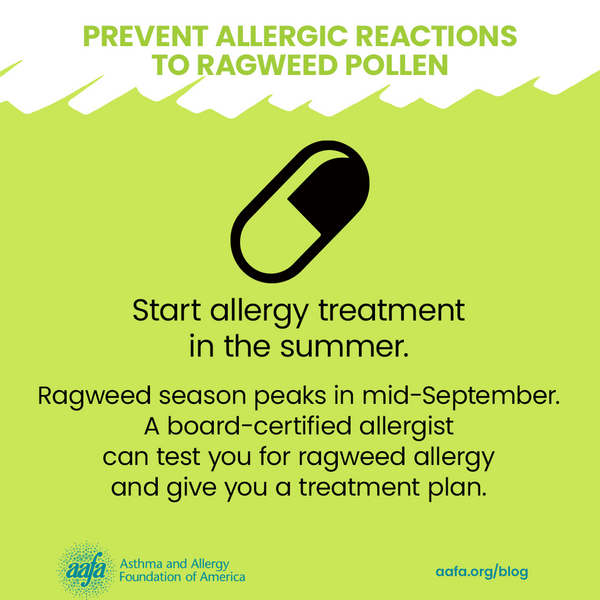
Ragweed Grows Throughout the United States
Ragweed is hard to escape. It grows throughout the United States. To help reduce your exposure to ragweed pollen, track ragweed season where you live. Check sites like AAAAI's National Allergy Bureau to follow pollen readings often.
Ragweed pollen peaks in the mornings. Plan your time outside for the afternoon and evenings when possible.
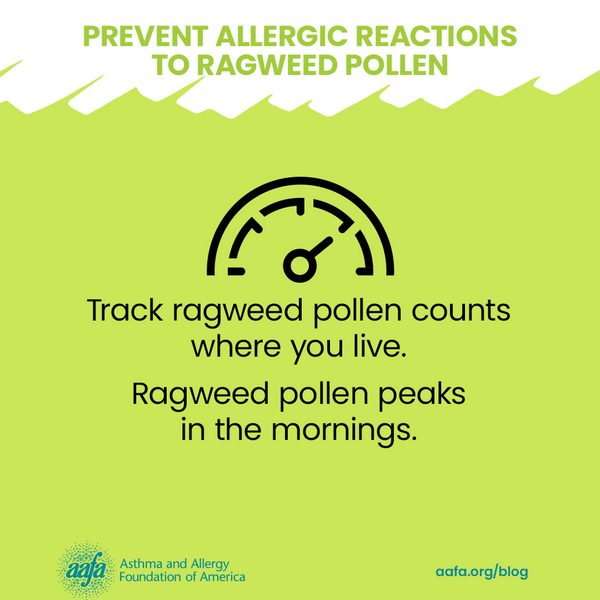
Your Immune System May Mistake Other Plants and Food for Ragweed
There are other plants that are related to ragweed. They may cause allergy symptoms as well. Avoid planting sunflowers, sage, burweed marsh elder, rabbit brush, mugwort, groundsel bush, and eupatorium near your home.
If you have a condition called pollen-food allergy syndrome (PFAS - also known as oral allergy syndrome (OAS), your mouth may itch or tingle when you eat certain foods. This is because the pollen is similar to the proteins in some foods, so your body can’t tell the difference. This is called cross-reactivity.
Food such as cantaloupes, bananas, watermelon, and sunflower seeds may cause symptoms in some people who have a ragweed allergy.
Rarely, PFAS can trigger anaphylaxis, a severe allergic reaction, so it is important to know if you have PFAS or a food allergy and how to treat it. Some of the symptoms of PFAS and anaphylaxis may be similar. If you have symptoms when eating foods, talk with an allergist.
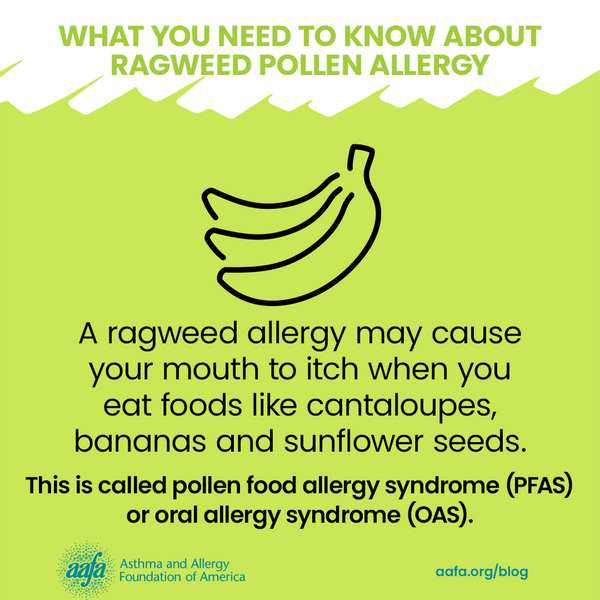
Ragweed Pollen Can Travel Hundreds of Miles
Ragweed pollen is very light, making it easy for the wind to carry it for miles. Don’t let ragweed follow you around. Cover your hair, eyes, and face when you go outside. Shower at night to remove pollen. Also have everyone who enters your home leave their shoes at the door.
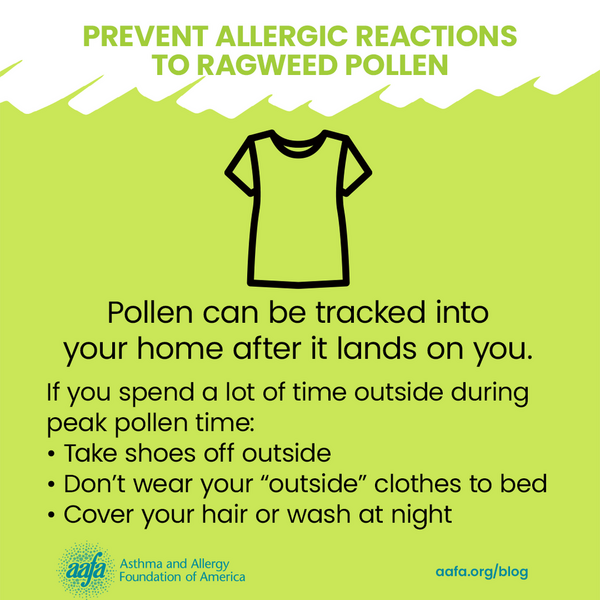
Immunotherapy May Provide Relief from Ragweed Pollen Allergy
If you are allergic to ragweed pollen, there are options for treatment. Many of them are available over the counter.
- Nasal corticosteroids – These nasal sprays treat nasal inflammation, reduce symptoms and congestion, and block allergic reactions. They are the most effective for nasal symptoms and have few side effects.
- Antihistamines – They work by reducing your runny nose, sneezing, and itching in your eyes and sinuses. Choose non-drowsy options.
- Decongestants – They shrink swollen nasal passages to help you feel less stuffy. Nose drops and sprays should be taken short term.
- Leukotriene inhibitors – This medicine blocks chemicals your body releases when you have an allergic reaction.
- Cromolyn sodium – This nasal spray blocks chemicals that cause allergy symptoms, like histamine and leukotrienes.
If over-the-counter allergy medicine doesn’t relieve your allergy symptoms, talk with your doctor about other treatment options. It is especially important for you to seek treatment if you have allergic asthma and ragweed pollen is a trigger for you.
Many people benefit from immunotherapy. This can come in the form of allergy shots or sublingual immunotherapy (SLIT).
With allergy shots, your doctor gives you injections of allergens in an increasing dose over time. You gradually become less sensitive to that allergen.
With SLIT, you take a small dose of an allergen under your tongue. You also gradually become less sensitive to that allergen. Currently, SLIT is available for ragweed and dust mite allergies.
The American College of Allergy, Asthma & Immunology and the American Academy of Allergy, Asthma & Immunology have tools to help you find a board-certified allergist in your area.
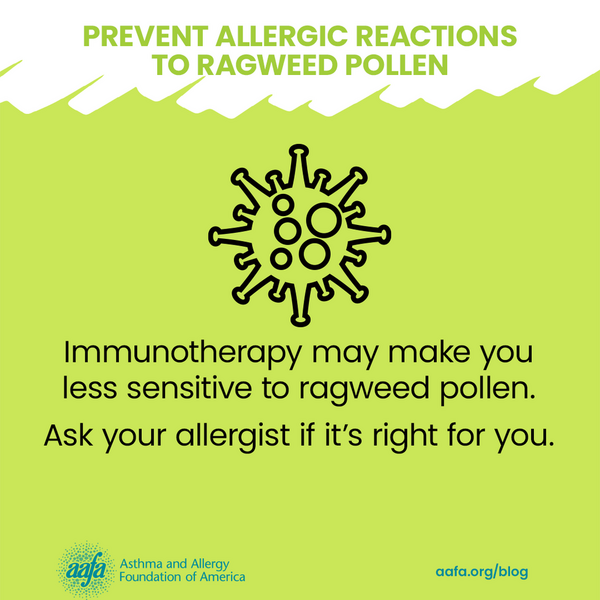
Wearing a Mask and Sunglasses During Ragweed Season May Reduce the Pollen’s Effects
Face masks can reduce your exposure to ragweed pollen. Wearing an N95 mask when outside can prevent pollen particles from entering your nose and lungs. This may lower your chance of having symptoms.
Sunglasses can protect your eyes from ragweed pollen too. Pollen can be irritating and may cause watery and itchy eyes. Also consider a hat to keep the pollen out of your hair.
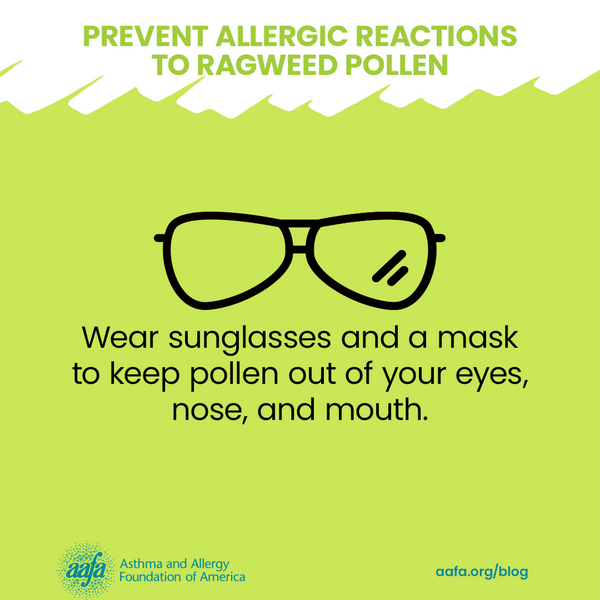
Healthy Indoor Air Quality Can Help You Manage Your Asthma and Allergies Overall
If ragweed pollen season drives you to spend more time indoors, pay attention to your indoor air quality. Indoor air is often more polluted than outside air. Poor indoor air quality can make your asthma and allergies worse. Combine poor indoor air quality with ragweed pollen, and you may be downright miserable.
The following can affect your indoor air quality:
- Allergens, like dust mites, pet dander, cockroaches, and mold
- Scents, chemicals, and volatile organic compounds (VOCs)
- Outdoor air pollution
Use our interactive Healthier Home Checklist to find where allergens, triggers, and irritants can hide. Then follow the steps to improve your indoor air.
Some products can help you improve and maintain good indoor air. The asthma & allergy friendly® Certification Program helps you find products that have been scientifically tested in labs and meet strict standards. These products have proven that they effectively remove or reduce your exposure to asthma and allergy triggers. Through our program, you’ll find CERTIFIED vacuum cleaners, air filters, bedding, flooring, and more.
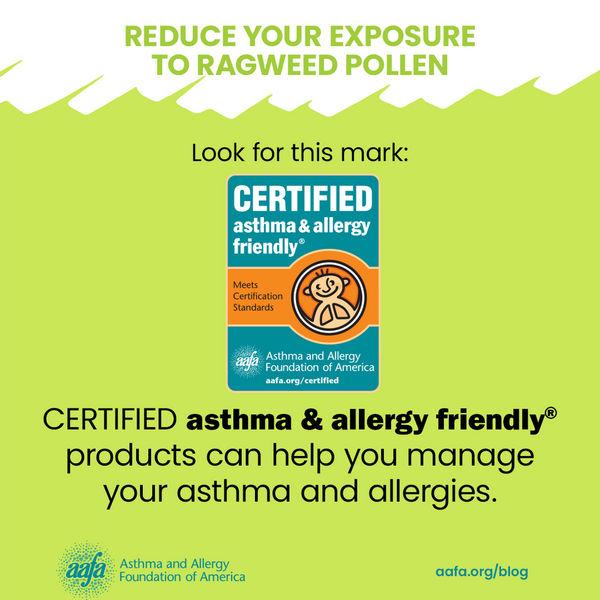
Medical Review Based off the webpage, “Ragweed Pollen Allergy,” reviewed August 2023 by Jill Poole, MD
Get answers to your asthma and allergy questions on our online forums.
Get Support Now







Comments (10)